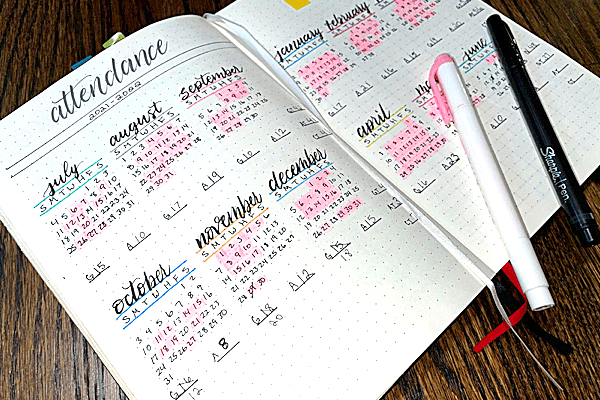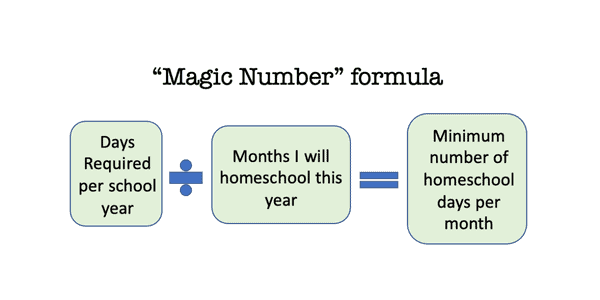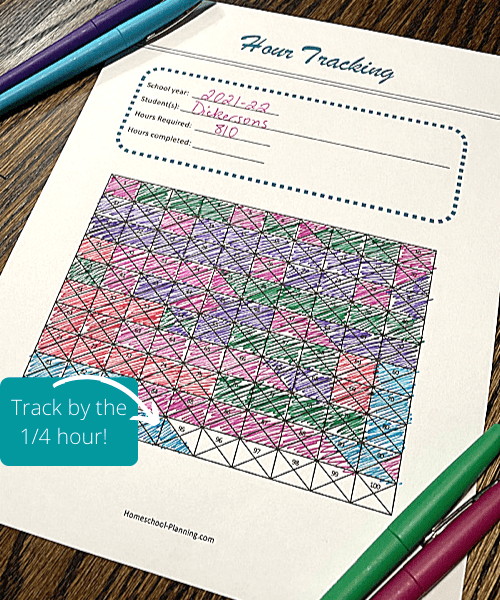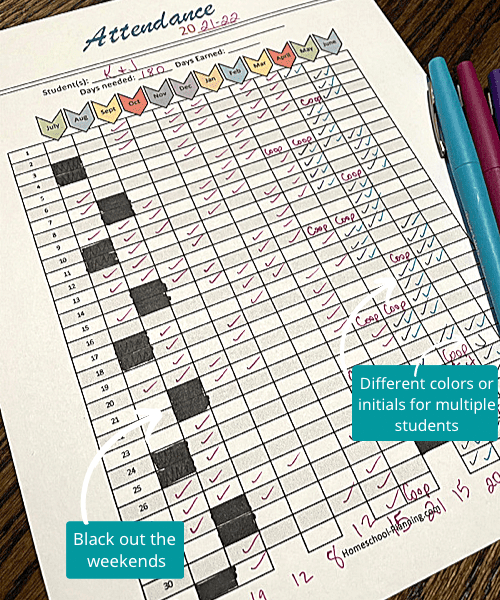Oh the dreaded homeschool attendance records. You may joyfully keep them, or maybe tracking attendance in your homeschool makes you cringe. In this post, you will find out why keeping attendance records are important and all the essentials of how to track them. Perhaps along the way, you’ll find the flexibility of a personalized homeschool calendar and learn that tracking records is not scary after all.

What do I need to keep track of for homeschooling?
Every state in the US requires homeschoolers to track things a little differently. So the first thing you should do is look up the specific homeschool laws in your state.
I really like the summaries on the Homeschool Legan Defense Association (HSLDA) website, as sometimes the direct law can be above my legal vocabulary understanding.
After the summary though, I do usually try to read through the actual applicable homeschooling laws myself, just to double check that nothing has changed since HSLDA updated their website. Usually these can be found on your state Department of Education website.
Some things that are often included and required within the state homeschool laws are:
- Attendance – days and/or hours
- Specific subjects
- Standardized testing
- Samples of work
- State reporting paperwork with deadlines
- Child’s age for required enrollment
You can find more about tracking the other things listed above on this site and others. In this post, I will only be covering attendance records. So this is tracking the days and hours.
Why should I keep homeschooling records?
- You may want them to look back on. For sentimentality sake, as well as practically for remembering what was covered. For instance, when planning school for other children.
- It may be required by law in your state
- You may need them for proof of homeschooling, if challenged
- You may need them if you put your kids in a traditional school program
- You may need records to participate in public school services, like speech therapy or athletics programs
- You may need records to reinforce your transcript, especially for a high schooler

How do homeschoolers keep attendance?
There are many ways to keep attendance records for your homeschool. A lot of the how to track depends on what is required of you and what you want to keep.
Some states require a certain number of days, often 180, per year. Georgia requires this.
Others may require a certain number of hours per year. For instance, as of this writing, Missouri requires 1,000 homeschool hours each year. 600 of these hours must be spent covering the basic core subjects.
Some states may require the days and hours. Like in Tennessee, homeschoolers are told to homeschool at least 180 days with 4 hours each of those days. But only the tracking of days is required to be turned in at the end of the year.
There are many homeschool attendance tracking sheets you can find online. These may look like a calendar where you cross off the days you did school. Or it may be a list of days you check off. Or this post uses a blank chart you fill in as you go. There is no right or wrong way to do it.
The same can be done for hours. You could track the hours on a spreadsheet, track them in a chart along with the days, or use an hour tracking app.
I have included an hour tracking sheet in my free PDF collection of printable attendance sheets! Download those here.
Keep on reading for examples of various ways to track. I have added a section below just for this!
No matter how you track, I do suggest you track as you go, rather than trying to look back and guess. This can be overwhelming.
Grab your own set of free attendance chart printables here!
Do I have to plan attendance in advance?
You definitely don’t have to schedule your attendance in advance. Though I like to. Here’s why:
- It helps me know if we’re on track for our year as we go along.
- It helps me relax on our days off cause I build most of those days in.
- It helps us all be able to push through rough weeks knowing there’s a break coming.
- It helps me not get lazy and take off too many days early in the year.
- It helps me plan around our crazy life and all the activities, trips, and other things happening.
I also suggest that you not only plan in advance but also track as you go. This will help prevent overwhelm and craziness at the end of the year when it’s time to report your attendance records.
Grab your own set of printable attendance sheets in our download collection!

Homeschool calendars
One of the best things about homeschooling is that you can choose not only what you teach your kids, but when! You can take off school when you want and arrange a homeschool calendar and annual schedule that works for your family.
Read: 7 Types of Homeschool Calendars and How to Plan Your Own
Here are 7 popular ways that homeschoolers plan their annual homeschool schedule.
1. Plan around your life
When I talk about planning around you life, you may be thinking that I’m suggesting you prioritize all of your other obligations and fit your homeschooling in around that. To some degree, this may be true. But ultimately, to be successful in your homeschool, your children’s education MUST come first.
So let me explain a bit more of what I DO mean. I am thinking about the big things in your life.
- The season of life you’re in.
- How old your kids are.
- Do you have lots of therapy or doctor appointments every week?
- Is a new baby coming?
- Maybe you are planning a move.
- Perhaps your family travels full-time.
- Are there toddlers in the mix?
All of these things can complicate things for a homeschooling family. But they are all a part of our rich lives. Your life may be a little unpredictable at times, or stressful all the time. You can’t always give your full attention for hours every day to your children’s schooling.
The beautiful thing here is that you can plan a homeschool schedule that allows for this. Planning in advance is very helpful in these circumstances so you always know where you need to be in school.
If you’re moving, expecting a baby, or taking a big trip, you can schedule a longer break to allow for those big moments off. Start your school year a little earlier than normal to get more done before the move. Pick open and go curriculum for after ‘maternity leave’.
Every year in our homeschool has looked different than the year before. We have schooled through babies, toddlers, an out-of-state move, and travel-nursing together as a family.
Homeschooling has allowed us freedom. We can make big decisions for our family without greatly affecting school with our kids. School is always pretty constant and stable.
Read: Play your year with free printable homeschool attendnace sheets

2. Your local public school schedule
Many homeschoolers will follow their local public school schedule for their homeschool year. I tend to recommend this to new homeschoolers, as having a pre-set schedule in advance can really help you be dedicated as you are finding your own family rhythm.
Many also like this calendar if their children have friends who are public schooled. This way when friends have days or weeks off, their children can be with them and not have to be stuck doing schoolwork.
But while a pre-made schedule may be nice, it is not required to follow the same schedule as your local publics schools.
3. Year Round homeschool schedule
A very popular way to schedule a homeschool year is to homeschool year-round. In simple terms, a year-round homeschool schedule is doing school…year-round! But this doesn’t mean that you never take breaks or anything.
Most people who have a year round homeschool spread their breaks throughout the year, rather than having one long break in the summer like traditional schools in the US.
This is what we do. I homeschool July-June, with breaks spread throughout the year. I always try to take the whole month of June off, but it has never once happened in 8 years of homeschooling! ugh! I get a little extra loose with extra days, so a few days usually bleed over into June. But that’s ok, because we have the freedom to do this. And honestly, I don’t think I could mentally handle homeschooling any other way! Some days I just need a day off.
Some who adopt a year-round homeschool schedule don’t worry about tracking days, or finishing curriculum. They have a routine for their days that they follow. And when one book is finished, they start the next! Time of year doesn’t matter.
Many who homeschool year round will also adopt one or more of the other calendar options I mention below. But the main point of this homeschool calendar is that there isn’t a defined homeschool start date or a set homeschool year end date.

4. Six-week homeschool calendar (Sabbath schooling)
A 6 week homeschool calendar is a great way to spread out your breaks throughout the school year. Those who use this schedule will usually do a solid 6 weeks of school followed by a whole week break. I’ve also heard this calendar called Sabbath Schooling. Resting on the seventh…week.
There also are a few extra weeks off you could throw in around the holidays, and here or there as you please. There are 52 weeks in a year, so 36 weeks of school leaves quite a bit of weeks off!
Many homeschool curricula are based on 30 or 36 weeks, which can easily be divided up into 6 week terms. So this schedule is not difficult to work into your resources.
This is also a good option for those families who like to take longer intentional breaks for projects or trips.
Of course, you could pick any number and use that, 6 isn’t required. Four weeks of school followed by 1 week off could also work great. Just a different way to spread out those off weeks.
5. Magic Number schedule
The magic number schedule is something I came across from Pam Barnhill. She talks about it in this post.
Basically, a magic number schedule is guided by finding your magic number of homeschool days per month.
First, start with the total number of days you plan to homeschool for the year, divide that number by the amount of months you’d like to school and that’s your magic number.
So say you need to homeschool for 180 days, but want to take June and December off. So you have 10 months left. Divide 180 by 10, and you get 18. So each of those 10 months you need to homeschool your kids for at least 18 days. This can be so freeing.
You could homeschool for the first 18 weekdays of the month then take off the rest of the month.
Or you could use it to help you schedule your days out each month, knowing you only need 18. Just so you know, for most months, 18 days of schooling allows you to take one day off each week.
It can also help you rest easy knowing you are on track, even if you do more days than your magic number. Who doesn’t like to get ahead?
I also really like this homeschool calendar system as it’s super flexible and allows for built in breaks.

6. Four-day homeschool week
A 4 day homeschool week can be a nice option for families that like frequent breaks. Or for those whose schedule is a little less consistent daily.
Many homeschoolers who choose a 4 day homeschool week do so because of co-ops they are involved in. They do their regular school work in those 4 days, then have freedom to do as they please at coops without pressure to have those classes fill gaps in their academics. (side note: co-op can totally count for school days!)
At the beginning of the year, I usually set out my projected homeschool attendance calendar with plans to homeschool 4 days a week. And some days I take this day off, and other days I won’t. I’d like to say I school that day so I can have an extra day off the next week. But I’ll be honest, it’s usually because I’m making up for an extra day I already took off!
7. Following the calendar year
I’ve never followed the calendar year in our homeschool, but this approach is intriguing. The basic idea is that rather than starting your year in or near August like traditional schools, you start the school year fresh as you start a new calendar year in January.
For me, once it gets close to the holidays in November and December, everything kind of explodes with holiday. Wrapping up a school year and focusing on the holidays sounds like a wonderful time.
And the excitement of a new calendar year mixed with a new school year could make it even more of a fresh start!
If you’d like to learn more about planning your own homeschool calendar, check out my post about using my free printable homeschool attendance sheets.

Homeschool time
I want to introduce you to what I call Homeschool Time. It’s a relaxed approach to counting those hours and days. Have you ever heard someone say they are on “Africa time”? This is usually in reference to the idea that those in Africa have a more relaxed approach to time than most Americans.
In the same way, there really is a bit of a relaxed sense when it comes to counting homeschool time. Many homeschoolers will easily be able to count hours their children spend on worksheets, but interest-led learning and play is harder to tally. But it all counts!
Your kids are learning all the time.
Now I am not at all saying to lie or make up your hours. Or to not do any structured school work and let your kids do whatever they want. But I am saying that not every homeschool hour is going to look like many would perceive as a homeschool hour – sitting and writing in a book.
Our desires deceive us, especially when we’re children. So I encourage you as a homeschool parent to not only allow your children to pursue interests but also to challenge them in ways they may not know to choose themselves.
So take advantage of the freedom of homeschool time. Count every hour and day your child is learning in all the various ways.
How many hours a day to homeschool?
So the amount of time each day you homeschool ultimately depends on your state laws. Some states want you to homeschool for 4 hours each day, some don’t specify, and others will not give you a daily but only yearly requirement. So start by finding out your requirements.
Now when it comes to tracking those hours, if you haven’t already read the section above on homeschool time, I suggest you do so.
Generally, these hours don’t have to be what you think of as school. Sitting down and working on a workbook, with a teacher lecture in front. But many of these hours can and should be spent doing other things as well.
Reading books, exploring nature, building something, creating something, practicing an instrument. These ideas only scratch the surface of what “counts” as homeschool time. Any time you feel your kids are learning, practicing, and strengthening a skill you should track those hours!
Not all people learn well from lectures or reading long passages. And not every topic is good to be learned in those fashions. Think about trade schools or any sort of program that requires hands on hours.
Doctors didn’t learn all there is to know about being a doctor from textbooks. Sure, they learned quite a bit. But then they spent time with people, asking questions, studying topics, trying out various procedures in controlled environments.
The same and maybe more is true for trades like mechanics, construction workers, brick layers….most of what they learn is from doing.
Your baby is learning when they stare at their hands, try to stay sitting and play with their food. A toddler is learning when they are practicing walking, stacking blocks, and climbing stairs. So why do we think it has to change once kids are school age?
Yes, some direct instruction is great and important. Expose your children to new things. Challenge them. And count those hours, mama!

Homeschool hours by grade
Think back to what I’ve said above about homeschool time and hour tracking. Now with that in your head, here is a list of my suggestions for the intentional homeschool time you spend with your child on a given day. The rest of the day should be spent learning in other ways like playing and following interests.
Even within these times, there will be variety of learning. Not even all intentional learning has to be done at a desk or from a book.
These suggestions are guided greatly by the amount of time a child of this age can focus well. Every child is different.
- Preschool/kindergarten: 30 minutes-1 hour
- Elementary: 1-2 hours
- Middle School: 2-3 hours
- High School: 4-5 hours
Keep in mind these are just suggestions, and in no way should be a limit to learning nor a standard to maintain.
Is 2 hours homeschooling enough?
I hear this one all the time. Is 2 hours enough for homeschooling? Well that depends on what you are counting as being included in those 2 hours. Also consider what they are doing outside of those 2 hours. And of course, what your state requires.
Are you spending 2 hours with your child doing intense teaching, then setting them free on a video game for the rest of the day? It’s debatable if the video game counts as learning, but some can.
If you are spending 2 hours intentionally helping your children learn in whatever ways work best for them, then they spend the rest of the day following their interests and learning, then yes. Two hours homeschooling is enough.
Most of my kids are able to finish their schoolwork within 1-2 hours in elementary school. As they get older, more time is required to complete what they are learning.
High schoolers technically should be spending 4-5 hours a day for around 180 days a year on their school work. This is the standard for high school credits. See more in that section below.

How can I keep track of homeschool hours?
There are many ways to track homeschool hours if you need or want to track them.
One simple way is to write down the hours you complete each day on your daily attendance tracker. You could also create a spreadsheet, or just make a simple list in your planner.
There are also various simple hour tracking charts you could design yourself or download. Download our hour tracking chart here! Then just color in or check off a box for each hour completed.
Hours can be tracked on an hour tracking app like what you may use working from home. There are so many. A couple free options to consider are Toggl and Clockify.
A hack for tracking hours for a book is to look up the book on audible or another audiobook site. See how many hours the audiobook is and record that amount of time for the book in your homeschool hour tracker.
For instance if you are reading a book here and there throughout the day, that can be hard to remember to track all those short increments of time. So instead, just look at the audiobook. If it is 12 hours long, just add 12 hours to your hour tracker once you have finished reading it.
Some homeschool textbooks even have audiobooks, so this can be a pretty nice hack to remember!
Get your own homeschool hours log printable in our free printable attendance sheet collection! Just follow this link to download.
High school credit requirements
While we’re on the topic of tracking hours, I want to be sure to mention high school credit requirements. In general, completing one high school class will award 1 credit on a transcript.
This credit is generally obtained by earning one Carnegie Unit, which is You completing 120 hours of study within the subject area. This ends up being around 45 minutes or so in a 180 day school year. Per subject.
The 120 hours of study will include all learning, including projects, tests, assignments, and even associated reading for the class. Anything that is done to acquire the knowledge is included.
It may be helpful to note that if tracking these credit hours seems daunting to you, know that completing a high school level curriculum will also earn the credit hour.
Tracking these hours for high schoolers can be particularly important in case the transcript is ever challenged.
Grab your own High school hour tracking sheet in our free collection of homeschool attendance forms! Download them here.
Homeschool attendance tracking examples
Margin, white space, and flexibility
If you’re not someone who plans in advance well, scheduling your homeschool may seem annoying or like it will box you in. I get it. I definitely can feel this way.
But something I have found to be necessary in our homeschool is to build in margin into our schedules to allow for flexibility.
Think with me if you will about a piece of paper that you just printed out. Maybe it’s a research paper. There is always white space around the edges in the margins. If your teacher fills up those margins with edits and notes, it is overwhelming.
Now think of your annual school calendar as one piece of paper. If you fill it up to the brim at the start, with no flexibility or built-in days off, you may feel “behind” from the start. When something comes up and you need to change plans, you add in a little note in the margin of your plan and it’s already getting complicated. Every week something will probably come up to change it so the more edits you make, the messier your schedule gets.
Instead, build in the margin to your calendar. Make it figuratively double-spaced with wide margins. This allows all kinds of edits all over. In between the lines, outside in the margins.
You may not feel like you will get as much done, but let’s face it. When you’re stressed out and always feeling stuck to a calendar, you won’t get much done either.
It’s a lot easier to add something in if you want to follow a rabbit trail than it is to push days around.
I beg you. For your sanity, build in margin and flexibility to your homeschool calendar. Pencil days in to keep you going, but don’t write them in permanent marker.
Conclusion
There are so many ways to approach homeschool attendance record keeping. Through this post, I hope you have learned what attendance tracking is, why it’s important for your homeschool, and many ways to accomplish the task. Counting the days and hours in your homeschool doesn’t have to be so scary or overwhelming. And building in flexibility and margin to your homeschool calendar will help keep you on track.
Do you have a favorite way to track attendance? I’d love to hear about it in the comments!
Related articles
Trusting your instincts in your homeschool
The Ultimate guide to planning your homeschool year
Plan your year in 7 simple steps
Plan your year with free printable homeschool attendance sheets






